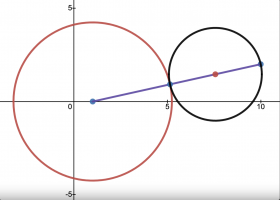Pramod Kumar Tandon
New member
- Joined
- Jun 7, 2021
- Messages
- 11
Find Radius of the circle passing through (10,2) and touching the circle (x-1)^2 + y^2 = 18 externally. I am just unable to solve it.
First an approximate sketch of both the circles would be useful. We would note that the centers of the circles and the point of tangency will be on the same straight-line.Find Radius of the circle passing through (10,2) and touching the circle (x-1)^2 + y^2 = 18 externally. I am just unable to solve it.
@Pramod Kumar Tandon I'll help you out with the sketch since the numbers are nasty, but not impossible.First an approximate sketch of both the circles would be useful. We would note that the centers of the circles and the point of tangency will be on the same straight-line.

You're right. I assume you copied the problem exactly as given?I used Geogebra to draw the figure. I found many ( may be infinite number) of circles passing through (10,2) and touching the given circle. So I think I must add at least one more point ( say 9,-1 ) to the question to get a single answer. But then how should I proceed ?
The revised question will be : Find Radius of the circle passing through (10,2) and (9,-1) and touching the circle (x-1)^2 + y^2 = 18 externally. I am just unable to solve it.
